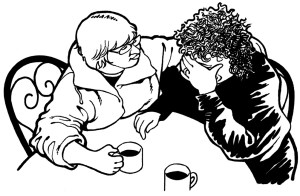Accessible summary: Use of physical restraint on locked wards
by Rebecca Fish
Physical restraint is holding somebody to stop them moving. It is done to stop harm to people or damage to property.
Staff sometimes use physical restraint to restrict someone’s freedom of movement.
When people think about staying in units, they often remember being physically restrained, or seeing other people being restrained.
The #7daysofaction campaign (www.sevendaysofaction.net) shows stories from people with learning disabilities and their families. They say how frightening restraint is.
 The Mental Health Act says that restraint should be used as a last resort. This means that staff should talk to people and try to calm them down before restraining them. Staff should also explain that the person will be restrained if they don’t calm down.
The Mental Health Act says that restraint should be used as a last resort. This means that staff should talk to people and try to calm them down before restraining them. Staff should also explain that the person will be restrained if they don’t calm down.
The Department of Health says that in some services, physical restraint is used too much and in harmful ways.
What do people with learning disabilities think?

Rebecca Fish
In some of my research work, I asked people about being restrained. I spoke to 16 women with learning disabilities who were in locked wards. They agreed that I could write what they said.
- The women said being restrained makes them even more angry.
- They said that they think restraint is not always used as a last resort.
- Sometimes, they told me that they were restrained for self-injuring.
- Some women told me there is no warning that they will be restrained.
 Being restrained made some of the women remember bad experiences and abuse from the past. This is worse when male staff restrain women.
Being restrained made some of the women remember bad experiences and abuse from the past. This is worse when male staff restrain women.
When there are bank staff working, they might not know people very well. This means that restraint might be used too often. People might feel like they are being punished when they are restrained.
I also spoke to 10 staff. They told me that they did not like restraining people but they said they had no choice. They told me that they use restraint as a last resort.
What needs to change?
- Services need to work with families better.
- Men should not restrain women.
- Staff should talk to people calmly and caringly while restraining.
Staff should talk to people to let them explain why they are angry.
 Services should help staff to make good relationships with service users. When relationships are good, restraint is not needed.
Services should help staff to make good relationships with service users. When relationships are good, restraint is not needed.
Staff need to protect service users from harm. Also, staff need to protect themselves from harm. If staff have more time to spend with people, they will be able to talk to people about what is making them angry. This might help staff and service-users to understand each other better.
Fish, RM and Hatton, C. 2017 ‘Gendered experiences of physial restraint on locked wards for women’ Disability & Society 32 (6) pp. 790-809. If you want to see the full article click here https://doi.org/10.1080/09687599.2017.1329711
Rebecca Fish You can email Rebecca r.fish1@lancaster.ac.uk or talk to her on twitter @BeckstaylorFish
All pictures used are from CHANGE www.changepeople.org


You must be logged in to post a comment.